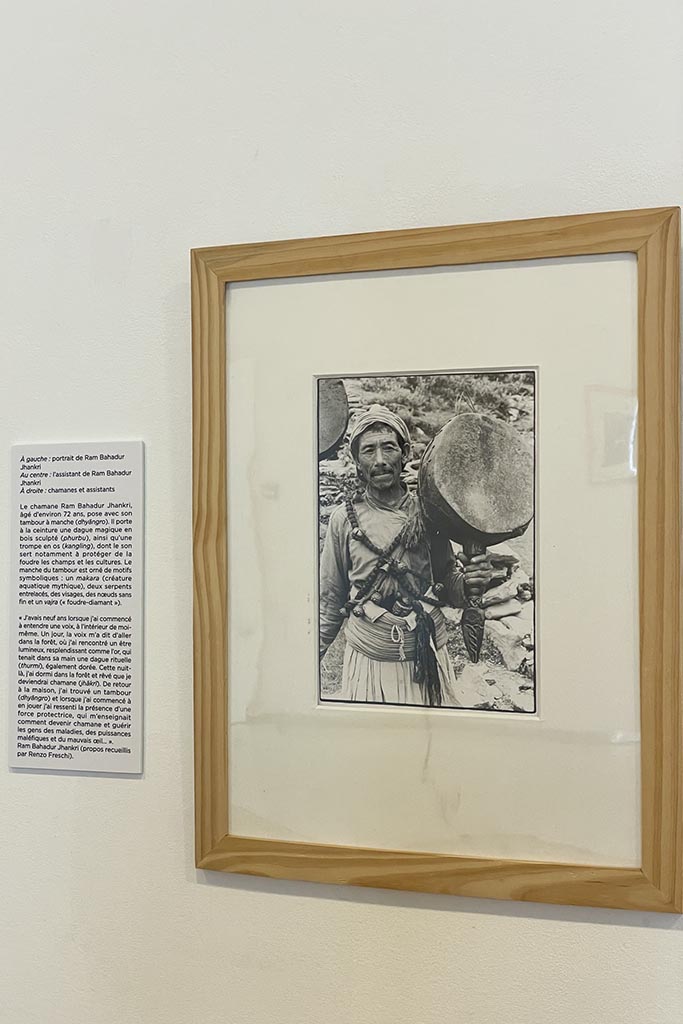
20 Sep KALINGCHOK, A SHAMANIC PILGRIMAGE IN NEPAL Nice, Musée des arts Asiatiques,
until I October
SHAMANS, DIALOGUES WITH THE INVISIBLE
Cannes, Musée des Explorations du Monde,
until10 November
In my life I had the good fortune of meeting shamans. It happened in Kathmandu in 1979 and in the next two years my curiosity brought me to seek them out and get acquainted with some of them. One in particular was Ram Bahadur Jhakri, whose fame in the mountains where he lived was matched by the very long, thin hair braid he had never cut since, still in his teens, he had felt he was a shaman and that the braid was the symbol of his power. He performed for me some trance rituals and, together with his young disciple, some ritual dances: a true experience with a world that until then I had only read and fantasized about.

I photographed those unforgettable moments and next year I managed to climb to the top of Kalingchok (3750 mt) to see the celebration of a goddess, patron of shamans, in which dozens of shamans and pilgrims took part who had climbed those steep mountain paths soaked with the monsoon rain.
In the beautiful Musée des Arts Asiatiques in Nice, designed by Kenzō Tange, some of the pictures documenting those extraordinary moments are on display. More than 40 years after I took them, these photos have become an historic document since so much has changed, not just in Kalingchok and in Nepal but in all those religious practices which, until the arrival of technology, of allopathic medicine and of roads, were for many peoples of the Earth the only possible means of trying to preserve the balance of man vis-à-vis disease, his relation with nature and the “invisible world”: a prerogative of shamans. However, the exhibition in Nice is also linked with another one -much more important- on the shamanic traditions of many other world populations organized by Christophe Roustan Delatour in the Cannes Museum of which he is the vice-director.
KALINCHOWK
Kalinchowk is the name of a small Hindu shrine perched on a solitary 3800mt high peak of central Nepal. During the full moon of the month of Saun (July-August), in the thick of the rainy season, a crowd of devotees comes here to seek blessing by Kali, the great Goddess, lady of the site. The pilgrimage is punctuated by singing, dancing, prayer recitations and offerings of flowers, rice, milk and sacrificial animals.
The photographs taken by Renzo Freschi in 1979 testify to the religious fervor of this festival to which tens of shamans participate, sole intermediaries between humans and the invisible powers. Equipped with their drums and ritual paraphernalia, the shamans compete among themselves, instruct young disciples, bless the faithful and pay homage to the mighty mountain spirits.
In Nepal the shaman (jhakri) is considered a healer endowed with supernatural powers. He can travel through the invisible world, tell the future, heal diseases afflicting individuals and the community. To get into a trance, perform rituals and combat baleful spirits, shamans employ various implements such as the drum, magical weapons and special objects serving as protection. This equipment includes materials and symbolic motifs meant to strengthen the shaman’s effectiveness and prestige. Renzo Freschi explains that “according to the local animistic belief, illness is caused by evil spirits or by witches, and only shamans have the power to heal”. It is in order to exorcize that unpropitious period (the monsoon favoring epidemics) that shamans gather every year at Kalinchowk to renew their powers, essential for them to serve and protect their communities.
“Chamanes, Dialogues avec l’invisible” is an introduction, through 150 exhibits from 19 countries obtained from museums, collectors and private galleries, to that “invisible world” frequented for thousands of years by the shamans. The ritual objects, sculptures, paintings, costumes, selected by a scientific committee chaired by François Pannier, are divided into seven thematic areas dedicated to the various aspects of the different shamanic traditions: what is a shaman; how to become a shaman; how to communicate with the spirits; how to relate with other living beings; ritual implements; healing and death; an insight into the invisible.
Alongside ancient items -belonging to shamans or their communities- works by living artists are also exhibited. Although modern, these are aimed at keeping alive the memory of traditions which, if forgotten, would lead to a loss of one’s own identity. Furthermore, videos shot on site show shamanic rituals still performed to this day. The exhibition is thus an important contribution to the knowledge of a tradition going back to the origins of the human community and it concludes with the fantastic recostruction of a tent in which a certain ritual of a Siberian ethnic group was celebrated. And so, in a particularly evocative space of the Museum, it is possible to get into the tent in which sounds and images evoking those created by the shaman are magically reproduced: what a marvel!
Renzo Freschi























No Comments